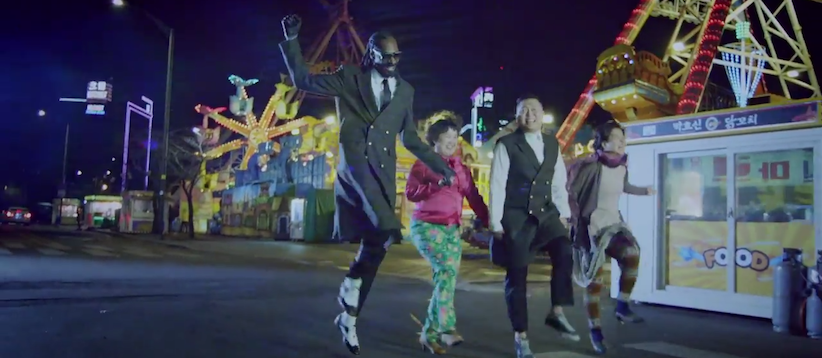In defence of Snoop Dogg
Making music videos with Psy? Snoop Dogg is actually just keeping it real
(Screen capture/Youtube)
Share

There was a time not so long ago when Calvin Broadus—the California rapper better known as Snoop Dogg and, more recently, Snoop Lion—was a terror to the mainstream. Long, lean and menacing, wearing his gang ties on his sleeve and regularly surrounded by swirls of skunky marijuana smoke, he was a sneering convicted drug dealer who was arrested for murder (the charge was later dropped) and rapped graphically of sex in a straitlaced time (naming his 1993 debut album Doggystyle was particularly audacious).
Certainly, Snoop Dogg isn’t the first rapper to be reviled and vilified this way. Eminem, with his vicious rhymes about killing his mother and beating his wife, had his time as America’s Latest Nightmare; more recently, it was the anarchic riot-inducing youths of the Odd Future collective in L.A., banned from even entering New Zealand as a “threat to public order,” and the nihilistic gunplay rap of Chicago’s “drill” subgenre.
It’s been 20 years since his two seminal gangsta albums, replete with their slithering California-baked funk samples, and he’s established himself as a rap icon, with a healthy catalogue of songs that have ranged from hits to shlock. But now, he’s back in a major way in the eyes of the collective consciousness–this time, for the pop song Hangover, a collaboration with the Korean sensation Psy, celebrating soju (rice liquor), noraebang (karaoke) and South Korea’s nightlife. They drink and do flips in a pool hall; there’s a scene where he, Psy and two middle-aged women frolic in a carnival. It’s earned more than 37 million incredulous views in two days. This isn’t the Snoop Dogg many of us have come to know.
They’re odd bedfellows at first blush, to be sure. So how did the Long Beach rapper once known for flossin’ with big chains find himself teaming up with a K-Pop artist we’ve dismissed as a one-hit wonder to make a candy-floss pop track?
It would be easy to dismiss Snoop as a sellout, and the video as but an act of desperation by a man who has historically twisted in the wind to help maintain his remarkable relevance. After all, Snoop Dogg is hip hop’s ultimate chimera: He’s been a gangsta, a pimp, even a reggaeton artist. This isn’t even his first dalliance into cutesy pop, lest we forget his curious appearance on Katy Perry’s California Gurls. But selling out would mean that Snoop isn’t being true to himself, when, in fact, Hangover shows quite the opposite.
That idea of being authentic, or “keeping it real,” is a fundamental tenet of rap music, a way to authenticate your background. It’s what makes long-time rap fans so uncomfortable with Rick Ross, who performs with the borrowed name of a major drug lord, despite once serving as a correctional officer; it’s what makes Drake, the rapper from a chi-chi Toronto neighbourhood who claims to have started from the bottom, a perpetual whipping boy. Even Snoop Dogg himself endured it, for his recent shift into reggae music as Snoop Lion, which was lambasted by genre stars such as Bob Marley bandmate Bunny Wailer, who believed his interest was superficial and that he hadn’t earned the right. For all the evolution in rap music, authenticity remains an important factor.
But his collaboration with Hangover is just another example of the kind of new authenticity that marks rap music today, of new geographies to shout out. Sure, Snoop Dogg was once the poster boy of the West Coast and its gun-riddled ghettos, but that’s just not his reality anymore. In 1996, he moved out of treacherous Long Beach and into Blaisdell Ranch in affluent Claremont, Calif., where he bought a $2-million home and expanded it into a 6,500-sq.-foot manse complete with pool and basketball court. He’s less a musician than a brand, with clothing lines and even his own line of vaporizers, all available from his “Snoopermarket.” And, as exemplified by his reality show, Snoop Dogg’s Father Hood—which shows Snoop getting into fairly standard antics with his well-to-do family—his life is very far from the streets he grew up in.
So the Psy record isn’t ridiculous; it actually makes a lot of sense. For the video, he was flown to Seoul and filmed the video over a non-stop 18-hour period; the trip appeared to be one big party. And behind the video’s bubble-gum aesthetic, Hangover is a kind of celebration of globalism, of jet-setting largesse, of international stardom, of partying to excess no matter where you are—and a perfect expression of the life Snoop Dogg actually lives today.
There’s no doubt that if 1993 Snoop Dogg met the Snoop from 2014, they wouldn’t recognize each other. There’s a real cognitive dissonance that occurs when you think about how much they’ve changed. But that’s not a bad thing; after all, it would be just as confounding, perhaps even more so, if he continued to rap about his gangland ties and gunplay. In fact, it would be inauthentic for him not to change. Hangover, for all its disposable qualities, is a reminder that Snoop Dogg doesn’t take himself too seriously, an unusual trait for a top rap icon. But it’s also a sneaky testament to the fact that he isn’t debasing himself—he’s actually just keeping it really real.